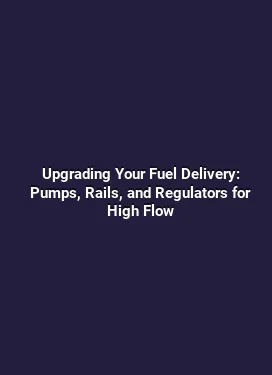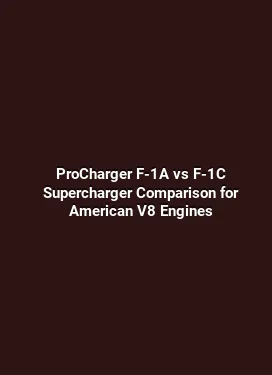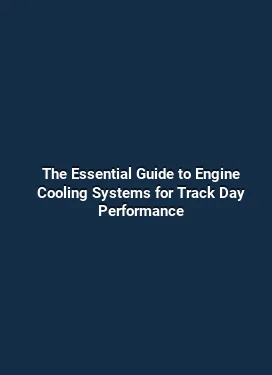Demystifying Compression Ratios: Finding the Sweet Spot for Your Fuel Type
Compression ratio is a foundational concept in internal combustion engines that directly ties to how efficiently fuel can be converted into usable power. Across gasoline, ethanol blends, diesel, and alternative fuels, the optimal compression ratio varies due to differences in flame speed, octane or cetane sensitivity, and knock resistance. Understanding how these factors interact helps engineers and enthusiasts tailor engine designs for the specific fuel landscape, balancing efficiency, performance, and durability. This article unpacks the mechanics behind compression ratios, examines how different fuels respond to compression, and offers practical guidance for selecting a ratio that matches your motive power goals and fuel options.
Understanding the role of compression ratio in engine performance

The compression ratio is the relationship between the maximum and minimum volume in the combustion chamber when the piston travels from bottom dead center to top dead center. A higher compression means a smaller unswept volume, more air-fuel charge density, and greater pressure rise during ignition. In theory, a higher ratio improves thermal efficiency because the engine can extract more work from the same amount of fuel, especially during the expansion stroke. In practice, the benefits hinge on how the fuel behaves under compression: flame speed, resistance to detonation, and the risk of pre-ignition all play decisive roles.
Modern engines exploit a spectrum of compression ratios by design. Naturally aspirated engines often aim for moderate to high ratios to maximize efficiency without inviting knock under wide-open throttle conditions. Turbocharged and supercharged engines can run lower static compression ratios because forced induction increases the in-cylinder pressure and temperature, which raises the likelihood of knock. This dynamic balance—compression, boost, and charge temperature—drives a large portion of a powertrain’s real-world performance and durability profile.
Fuel characteristics that shape the optimal compression ratio
Different fuels respond distinctly to compression. Gasoline, ethanol blends, diesel, and alternative fuels each have unique properties that influence knock resistance and thermal efficiency. When selecting a compression ratio for a given fuel, several practical factors come into play.
Gasoline and hydrocarbon blends

Gasoline has a broad octane range, with higher octane fuels resisting knock more effectively. Engines designed for premium fuels often feature higher compression ratios, enabling better thermal efficiency and improved part-load efficiency. However, knock resistance is not the sole constraint; fuel-air mixing quality, intake temperature, and engine calibration also determine the practical upper limit. In high-load scenarios, heat transfer losses, friction, and piston ring sealing become significant considerations that cap the usable compression ratio.
When ethanol blends are introduced, the picture shifts. Ethanol has a higher heat of vaporization and a different stoichiometric mixture, which can alter in-cylinder cooling and flame development. Moderate increases in compression can unlock efficiency gains with ethanol blends, but the enhanced cooling effect may also shift the optimal balance toward slightly different ratios compared with pure gasoline.
Diesel and high cetane fuels
Diesel engines operate on compression ignition rather than spark ignition. They rely on very high compression ratios to raise in-cylinder temperatures enough for auto-ignition of the diesel fuel. Diesel fuels typically tolerate higher compression ratios with less risk of knock in the gasoline sense, but durability, mechanical stress, and fuel spray characteristics still constrain the practical maximum. In modern diesel design, the compression ratio is tuned along with advanced fuel injection strategies (timing, pressure, pilot injections) to optimize efficiency and emissions rather than simply maximizing compression.
For alternative fuels with higher energy content or different ignition behavior, the optimal compression ratio can shift again. For example, fuels with higher knock resistance may accommodate slightly higher ratios, while those with different ignition delay characteristics may benefit from calibrated compression and timing to avoid premature combustion or incomplete combustion events.
Practical considerations for matching compression ratio to fuel type
Selecting a compression ratio is seldom a matter of a single number; it is an integrated engineering choice that accounts for the entire propulsion path. The following practical considerations help translate theory into real-world results.
Engine architecture and induction system
Natural aspiration versus forced induction dramatically influences the usable compression ratio. A turbocharger or supercharger effectively increases in-cylinder pressures during intake and compression, which can raise the propensity for knock if the compression ratio is kept high. Designers often opt for a lower static compression ratio in boosted applications to maintain a safety margin against knock while using boost to achieve peak power. Intercoolers and charge-air cooling further expand the envelope by reducing intake air temperature, enabling higher effective densities at the same boost pressure.
On naturally aspirated engines, a higher static compression ratio can yield meaningful gains in thermal efficiency since there is no boosted pressure masking the compression event. However, this must be balanced against the engine’s tolerance for knock and the tolerances of the fuel system, air handling, and cooling architecture.
Ignition strategy, timing, and fuel timing
For spark-ignition engines, ignition timing interacts with compression in determining the onset of detonation. Advanced ignition timing can be used to extract more power from higher compression ratios, but it tightens the margin to knock. Calibrations often use adaptive or variable timing strategies to maintain consistent performance across operating conditions, while fuel-injection strategies contribute to flame initiation and mixture homogeneity that influence the effective knock resistance at a given compression ratio.
Diesel engines rely on precise injection timing and multiple injection strategies to control temperature and pressure rise. Even with a high compression ratio, optimized fuel spray, injection pressure, and pre-injection strategies mitigate the risk of uncontrolled combustion and maximize efficiency across the engine map.
Real-world examples: how compression ratio choices translate to performance
To illustrate the interplay between compression ratios and fuel types, consider three representative scenarios that engineers commonly model during development. Each example highlights the trade-offs between efficiency, power, and reliability under different fueling conditions.
Scenario A: A high-efficiency, naturally aspirated gasoline engine
In this setup, a moderate to high compression ratio (for example, in the mid to high teens) is pursued to maximize thermal efficiency. The engine tuning emphasizes precise air path control, refined cam timing, and intake temperature management to preserve knock resistance. Ethanol blends up to E10 or E15 can be accommodated with careful calibration, exploiting ethanol’s cooling effect to sustain a favorable air-fuel mixture and minimize peak peak temperatures during combustion.
Outcomes typically include improved brake thermal efficiency, better part-load efficiency, and smoother torque delivery. The challenge is maintaining emissions and durability across a broad operating envelope, especially in hot climates where cooling demand is higher and knock margins shrink slightly.
Scenario B: A turbocharged gasoline engine targeting peak power
Boosted applications often trade some static compression for higher boost pressure and more aggressive timing strategies. A lower base compression ratio reduces knock risk under high boost, while the turbocharger provides the necessary density increase for high power output. Diesel-like thermodynamics emerge at peak load, but spark-ignition control and advanced fuels maintain acceptable emissions. Choosing a compatible fuel with adequate octane helps preserve performance without compromising reliability under sustained high-load operation.
In this scenario, fuel quality and engine calibration are critical. Premium fuels with higher resistance to detonation allow the engine to exploit broader timing margins, delivering the promised power while keeping exhaust temperatures in check and reducing the likelihood of detonation-induced damage to pistons or valves.
Scenario C: A modern diesel engine with advanced injection strategies
Diesel engines rely on compression to achieve ignition. A carefully selected compression ratio—typically higher than gasoline engines—must be balanced with injection timing, fuel spray pattern, and exhaust aftertreatment. Modern diesels also use multiple injections and advanced control strategies to smooth pressure rise. The resulting efficiency gains come with the responsibility of managing soot formation, NOx emissions, and soot particulate control through exhaust treatment systems. Fuel characteristics such as cetane number and sulfur content directly influence the practical compression ratio and injector calibration in this context.
Practical steps to optimize compression ratio for your use case
Whether you are tuning a street car, building a race engine, or optimizing a commercial powertrain, the following steps help align compression ratio with fuel type and performance goals.
1) Define your operating envelope
Map the expected load, RPM range, and environmental conditions. Identify whether boost will be used, what fuels are in scope, and the acceptable level of emissions and durability targets. This foundation informs the allowable compression window and calibration strategy.
2) Assess fuel characteristics
Consider octane or cetane ratings, energy content, ethanol content, and ignition behavior. Fuels with higher resistance to premature combustion allow higher compression or more aggressive timing, while fuels with lower resistance require careful control to avoid detonation and pre-ignition.
3) Model thermodynamics and heat management
Thermal efficiency improves with higher compression, but heat transfer losses and friction rise with higher pressure. Evaluating cooling capacity, oil and coolant temperatures, and heat rejection paths helps determine whether the system can sustain a higher compression ratio without sacrificing reliability.
4) Calibrate ignition and injection strategies
Adjust timing, fuel delivery, and injection rate shape to minimize knock and smoke formation. For boosted engines, align boost pressure with the chosen compression ratio to maintain a stable combustion process.
5) Validate with real-world testing
Dyno tests, road trials, and longevity assessments confirm that the selected compression ratio delivers the promised efficiency and power across aging and climate variations. Emissions testing further validates compliance and durability expectations.
How to communicate findings and set expectations for different audiences
When presenting results to stakeholders, it helps to translate technical outcomes into tangible performance metrics: brake specific fuel consumption (BSFC), peak brake horsepower, torque curves, and response behavior under varying temperatures. For enthusiasts, translating the data into drive feel, throttle response, and acceleration benchmarks provides a more intuitive sense of the advantages and trade-offs involved in compression ratio decisions.
Maintenance implications and long-term considerations
Engine health depends on consistent fuel quality, proper lubrication, and controlled operating temperatures. Higher compression, especially when paired with aggressive timing or boost, can elevate cavity temperatures and accelerate wear on piston rings and valves if the cooling and lubrication systems are not up to the task. Regular maintenance, including monitoring knock tendencies, fuel quality, and injector health, becomes more critical as compression strategies push the envelope.
Durability testing should extend beyond peak power events to cover part-load, rapid transients, and sustained high-temperature operation. Emissions controls, including particulate filters and catalytic converters, are sensitive to fuel quality and combustion stability, so matching compression ratio to a reliable fueling plan helps sustain long-term compliance and performance.
Summary of key takeaways about compression ratios and fuel types
- The compression ratio influences thermal efficiency and knock resistance, with higher ratios offering efficiency gains under suitable conditions.
- Fuel properties, including ignition behavior and energy content, set practical limits on usable compression.
- Engine architecture (turbocharged vs naturally aspirated) and ignition/injection strategies shape the feasible compression window.
- Real-world performance emerges from a holistic balance of compression, boost, fuel quality, and cooling capacity.
- Thorough testing and calibration across operating conditions are essential to achieve the intended efficiency and reliability outcomes.
As engines evolve with new fuel formulations and advanced control strategies, the quest to find the sweet spot for each fuel type continues. The art lies in harmonizing compression with combustion, boosting, and cooling to unlock sustained power, efficiency, and durability across the engine’s life cycle.






